The Tomb of Seti I, located in the Valley of the Kings on the West Bank of Luxor, Egypt, is one of the most significant and beautifully preserved royal tombs in ancient Egyptian history. Renowned for its stunning mural paintings, the tomb offers an extraordinary glimpse into the artistic achievements of ancient Egypt. These murals not only showcase the skill of Egyptian artists but also reveal the rich religious beliefs and funerary practices of the time. Follow archeology.dulichvn.net to discover many hidden mysteries that have yet to be discovered.
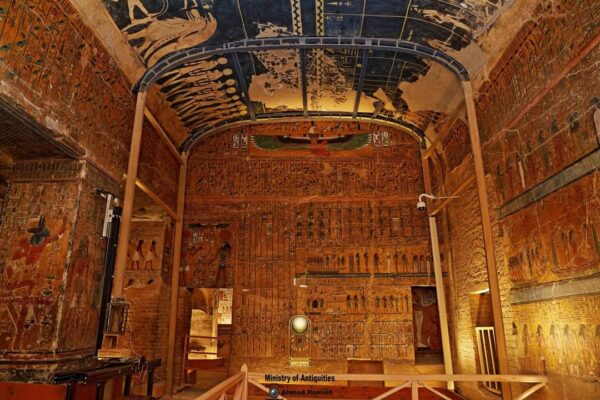
Discovering the Tomb of Seti I
The Historical Significance of Seti I’s Tomb
Seti I, the second pharaoh of the 19th Dynasty, ruled Egypt from 1290 to 1279 BCE. His tomb, designated KV17, is considered one of the most elaborate and artistically advanced tombs in the Valley of the Kings. It was constructed to honor the pharaoh’s journey to the afterlife and ensure his immortality. The tomb is renowned for its exquisite wall paintings, which depict various gods, mythological scenes, and royal iconography. These murals are critical in understanding the religious and cultural values of the New Kingdom.
The Discovery and Excavation
The tomb of Seti I was rediscovered in 1817 by the Italian explorer Giovanni Belzoni. Upon entering the tomb, Belzoni was astonished by the grandeur and complexity of the murals, which were well-preserved despite the tomb’s age. The intricate wall paintings and their vibrant colors offered a rare insight into the artistic mastery of ancient Egypt. Over the years, the tomb has undergone extensive restoration efforts to preserve its delicate artwork and prevent further deterioration.
Artistic Techniques and Materials
The mural paintings in the Tomb of Seti I were created using traditional Egyptian techniques, with artists applying natural pigments to the smooth plastered walls of the tomb. These pigments were derived from minerals and plants found in the surrounding environment, which were mixed with water and binder to create the rich colors that still captivate visitors today. The level of detail in these murals is exceptional, showcasing not only the technical skills of the artists but also their deep understanding of iconography, symbolism, and the complex religious beliefs of the time.
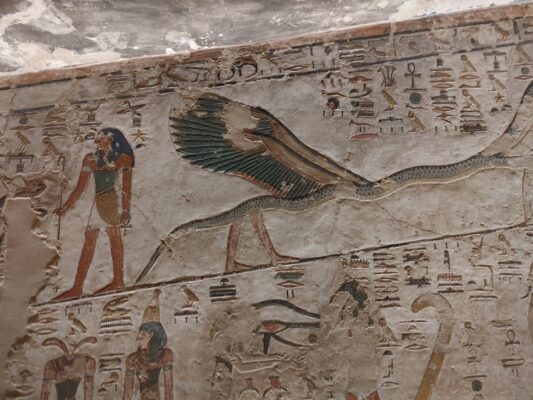
The Mural Paintings: A Glimpse Into Ancient Egyptian Beliefs
Depictions of Gods and Divine Figures
The walls of Seti I’s tomb are adorned with scenes of gods and divine beings, including the prominent Egyptian gods Osiris, Isis, Ra, and Horus. These gods were central to the religious life of the ancient Egyptians and were believed to govern all aspects of the universe, from life and death to the movements of the stars. The murals portray the gods in their idealized forms, with their distinctive symbols and attributes that convey their powers and roles in Egyptian cosmology.
The detailed depictions of these divine figures highlight the importance of religious worship and the afterlife in the ancient Egyptian worldview. The presence of gods in Seti I’s tomb emphasizes his divine right to rule and his expected journey into the afterlife, where he would join the gods in eternity.
Scenes of the Afterlife Journey
In addition to the depictions of gods, the murals in Seti I’s tomb also illustrate scenes from the pharaoh’s journey to the afterlife. These scenes are based on the Book of the Dead and other funerary texts, which describe the various trials and obstacles a soul must overcome after death. Seti I is shown being guided by gods and divine beings, symbolizing his safe passage through the dangerous underworld to the afterlife.
The detailed imagery of this journey is not just a representation of Seti I’s individual passage but a broader reflection of Egyptian beliefs surrounding death, resurrection, and eternal life. The tomb’s paintings serve as a visual guide, assisting Seti I’s soul in its transition to the afterlife and ensuring his immortality.
The Royal Iconography of Seti I
The murals in Seti I’s tomb also include numerous depictions of the king himself, emphasizing his divine kingship and his role as the mediator between the gods and the people. In these images, Seti I is often portrayed in a regal pose, wearing the crown of Upper and Lower Egypt and performing rituals in honor of the gods. These depictions underscore the pharaoh’s authority and power, both in life and in the afterlife.
The royal iconography in the tomb reflects the ancient Egyptian belief that the king was not only a ruler of the living but also a key figure in the divine order of the cosmos. The scenes of Seti I performing religious rites and interacting with gods reinforce his divine connection and his central role in the maintenance of harmony in the universe.
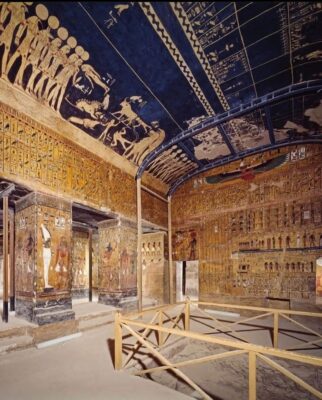
See more: The Ancient Roman Road Connecting Antakya and Aleppo: A Marvel of Roman Engineering
Preservation and Restoration Efforts
The Fragility of the Murals
Over the centuries, the murals in Seti I’s tomb have been exposed to various threats, including natural decay, humidity, and human interference. As one of the most delicate and important tombs in the Valley of the Kings, preserving these murals has been a priority for archaeologists and conservators. Despite the tomb’s relatively well-preserved condition, some sections of the murals have suffered from fading, cracks, and damage caused by the passage of time.
Ongoing Conservation Projects
Restoration efforts in the Tomb of Seti I have been ongoing for decades. In the 1980s, Egyptian authorities, in collaboration with international conservation teams, initiated a major restoration project to stabilize the tomb and protect its fragile artwork. The use of modern technology, such as digital imaging and 3D scanning, has allowed experts to document the murals in detail, helping to guide conservation efforts and prevent further deterioration.
These restoration projects have helped maintain the vibrancy of the murals, ensuring that visitors to the tomb can continue to appreciate the artistry and cultural significance of Seti I’s burial chamber.
The Tomb’s Current Status
Today, the Tomb of Seti I remains one of the most visited and studied tombs in the Valley of the Kings. Though access to the tomb is restricted to protect its delicate environment, tourists and researchers can still marvel at the murals through detailed photographs and virtual tours. The tomb stands as a testament to the grandeur of ancient Egyptian art and culture, offering invaluable insights into the religious and royal practices of the New Kingdom.
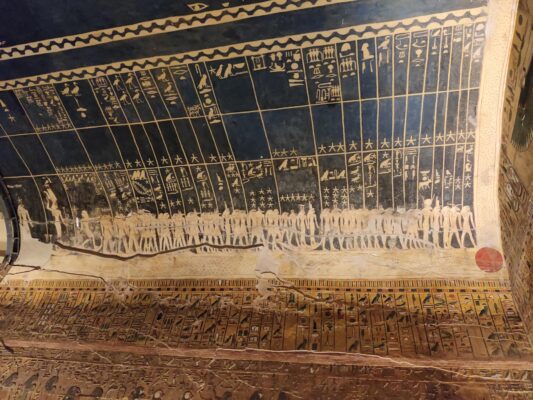
Conclusion: The Legacy of Seti I’s Mural Paintings
The mural paintings in the Tomb of Seti I are not only a visual marvel but also a profound reflection of ancient Egyptian beliefs, culture, and artistry. Through their intricate details, these murals transport viewers to a time long past, revealing the deep spiritual connection the Egyptians had with their gods and the afterlife. The tomb’s preservation ensures that future generations will continue to appreciate the remarkable achievements of Seti I and the legacy of ancient Egyptian civilization.
Whether as an artistic masterpiece or a spiritual document, the murals of Seti I’s tomb remain a pivotal part of Egypt’s rich cultural heritage, offering an enduring legacy for all who seek to understand the mysteries of the ancient world.

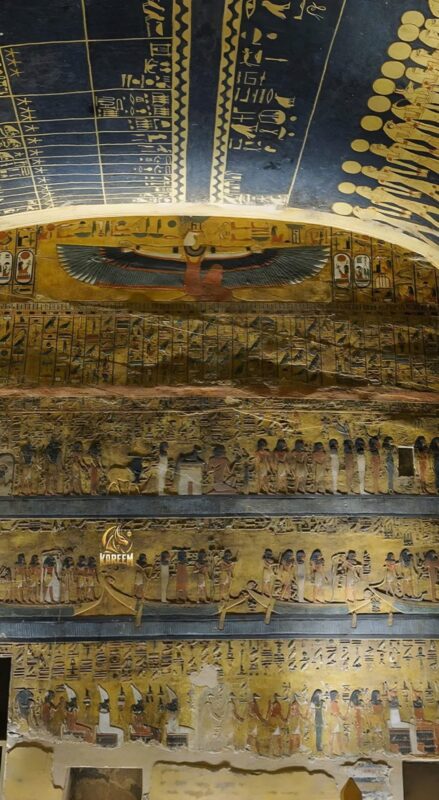
CÁC TIN KHÁC
Mary Walton: The Forgotten Inventor Who Helped Clean Up America’s Cities
Tomb of Queen Nefertari in the Valley of the Queens, Egypt
Discover the Hypostyle Hall of the Temple of Hathor at Dendera
Venus de Losange: Unveiling the Mystery of a 20,000-Year-Old Paleolithic Icon